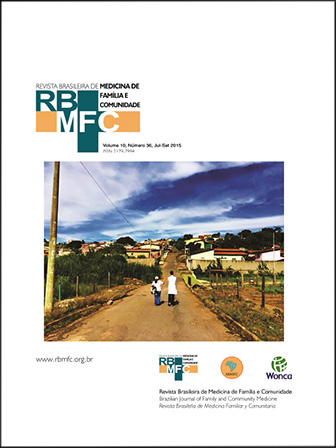Accuracy of weighing infants with the diaper on in primary health care
DOI:
https://doi.org/10.5712/rbmfc10(36)978Keywords:
Validity of Tests, Body Weight, Infant, Primary Health Care, Child Health ServicesAbstract
Objective: to estimate the bias introduced by weighing infants with the diaper on in primary health care. Methods: we enrolled infants who were about to be weighed at a primary care center and weighed each infant twice - once without the diaper and once with the diaper on - after the scale had been tared with a dry diaper. The bias was calculated, as the percentage difference in weight, by first subtracting the no-diaper weight from the diaper-on weight and then dividing the result by the no-diaper weight. Results: we enrolled 30 infants from July 23 to August 1, 2013. Most infants were present for a scheduled medical doctor’s visit, and their diapers had been changed less than 45 minutes before. The mean percentage difference in weight was 0.3% (95% confidence interval, 0.2% to 0.5%). Conclusion: we found a substantial agreement between the two weighing techniques. The bias (that is, loss of accuracy) introduced by weighing infants with the diaper on compared favorably with the precision of the standard technique and the physiological variability of the infants’ weights. Our findings suggest that weighing infants with the diaper on may be a valid technique for the cross-sectional assessment of the nutritional status in primary health care settings. However, further research is needed before it is used for the longitudinal assessment of the weight velocity.
Downloads
Metrics
References
WHO Expert committee on physical status: the use and Interpretation of Anthropometry. Annex 2. In: Physical status: the use and interpretation of anthropometry: report of a WHO Expert Committee. Geneva: World Health Organization; 1995. p.424-38.
de Onis M, Onyango AW, Van den Broeck J, Chumlea WC, Martorell R. Measurement and standardization protocols for anthropometry used in the construction of a new international growth reference. Food Nutr Bull. 2004;25(1 Suppl):S27-36.
Sucupira ACSL, Zuccolotto SMC. Semiologia da criança normal. In: Marcondes E, Vaz FAC, Ramos JLA, Okay Y, eds. Pediatria básica: Tomo1: pediatria geral e neonatal. 9a ed. São Paulo: Sarvier; 2002. p.148-57.
Aerts DRG de C, Giugliani ERJ. Vigilância do estado nutricional da criança. In: Duncan BB, Schmidt MI, Giugliani ERJ, eds. Medicina ambulatorial: condutas de atenção primária baseadas em evidências. 3a ed. Porto Alegre: Artmed; 2004. p.180-9.
Lopes LA, Weffort VRS, Patin RV, Dantas Filho S, Palma D. Avaliação do estado nutricional. In: Lopez FA, Campos Júnior D, eds. Tratado de pediatria: Sociedade Brasileira de Pediatria. Barueri: Manole; 2010. p.1605-22.
Keane V. Assessment of growth. In: Kliegman R, Stanton BF, Schor NF, Geme III JWS, Behrman RE, eds. Nelson textbook of pediatrics. Philadelphia: Elsevier/Saunders; 2011. p.39. http://dx.doi.org/10.1016/B978-1-4377-0755-7.00013-0
Gordon CC, Chumlea WC, Roche AF. Stature, Recumbent Length, and Weight. In: Lohman TG, Roche AF, Martorell R, eds. Anthropometric standardization reference manual. Champaign: Human Kinetics Books; 1988. p.3-8.
Brown KH, Creed de Kanashiro H, del Aguila R, Lopez de Romana G, Black RE. Milk consumption and hydration status of exclusively breast-fed infants in a warm climate. J Pediatr. 1986;108(5 Pt 1):677-80. DOI: http://dx.doi.org/10.1016/S0022-3476(86)81040-X
Johnson TS, Engstrom JL, Gelhar DK. Intra- and interexaminer reliability of anthropometric measurements of term infants. J Pediatr Gastroenterol Nutr. 1997;24(5):497-505. DOI: http://dx.doi.org/10.1097/00005176-199705000-00001
Bland JM, Altman DG. Measuring agreement in method comparison studies. Stat Methods Med Res. 1999;8(2):135-60. doi: 10.1177/096228029900800204
Bland JM, Altman DG. Comparing methods of measurement: why plotting difference against standard method is misleading. Lancet. 1995;346(8982):1085-7. DOI: http://dx.doi.org/10.1016/S0140-6736(95)91748-9
Mueller WH, Martorell R. Reliability and accuracy of measurement. In: Lohman TG, Roche AF, Martorell R, eds. Anthropometric standardization reference manual. Champaign: Human Kinetics Books; 1988. p.83-6.
Kent JC, Mitoulas LR, Cregan MD, Ramsay DT, Doherty DA, Hartmann PE. Volume and frequency of breastfeedings and fat content of breast milk throughout the day. Pediatrics. 2006;117(3):e387-95. DOI: http://dx.doi.org/10.1542/peds.2005-1417
Myo-Khin, Thein-Win-Nyunt, Kyaw-Hla S, Thein-Thein-Myint, Bolin TD. A prospective study on defecation frequency, stool weight, and consistency. Arch Dis Child. 1994;71(4):311-3. DOI: http://dx.doi.org/10.1136/adc.71.4.311
Lemoh JN, Brooke OG. Frequency and weight of normal stools in infancy. Arch Dis Child. 1979;54(9):719-20. DOI: http://dx.doi.org/10.1136/adc.54.9.719
Downloads
Published
How to Cite
Issue
Section
License
By submitting a manuscript to the RBMFC, authors retain ownership of the copyright in the article, and authorize RBMFC to publish that manuscript under the Creative Commons Attribution 4.0 license and identify itself as the vehicle of its original publication.















